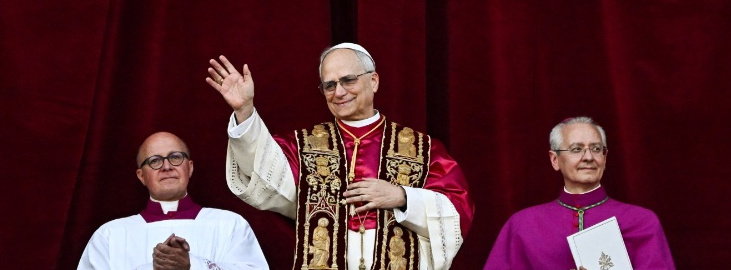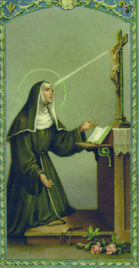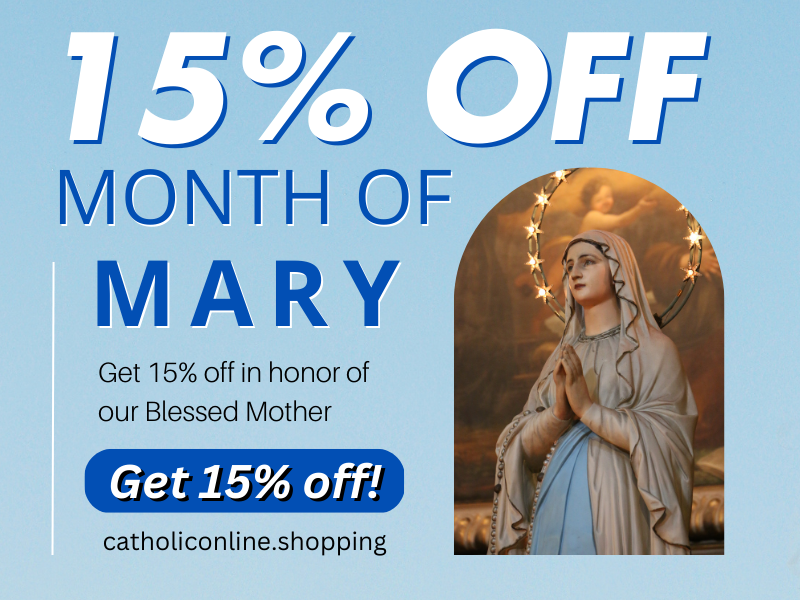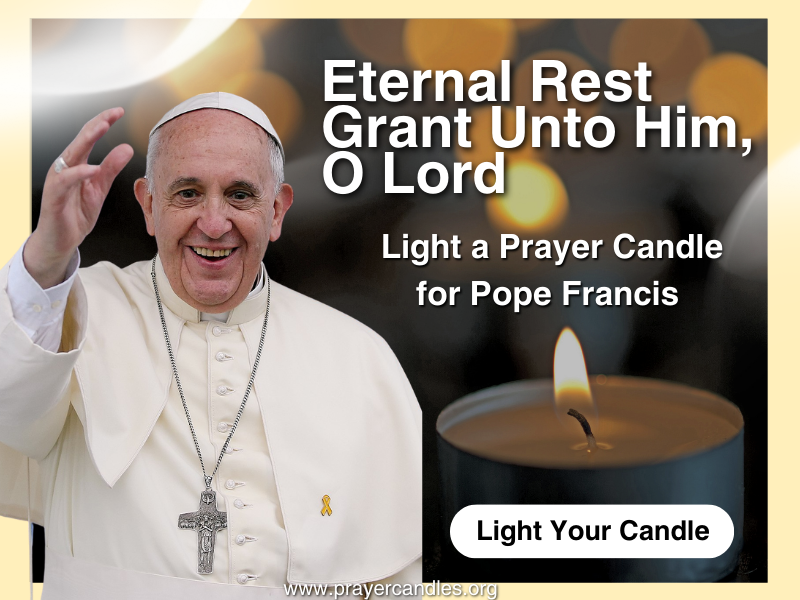 Dear readers, Catholic Online was de-platformed by Shopify for our pro-life beliefs. They shut down our Catholic Online, Catholic Online School, Prayer Candles, and Catholic Online Learning Resources essential faith tools serving over 1.4 million students and millions of families worldwide. Our founders, now in their 70's, just gave their entire life savings to protect this mission. But fewer than 2% of readers donate. If everyone gave just $5, the cost of a coffee, we could rebuild stronger and keep Catholic education free for all. Stand with us in faith. Thank you. Help Now >
Dear readers, Catholic Online was de-platformed by Shopify for our pro-life beliefs. They shut down our Catholic Online, Catholic Online School, Prayer Candles, and Catholic Online Learning Resources essential faith tools serving over 1.4 million students and millions of families worldwide. Our founders, now in their 70's, just gave their entire life savings to protect this mission. But fewer than 2% of readers donate. If everyone gave just $5, the cost of a coffee, we could rebuild stronger and keep Catholic education free for all. Stand with us in faith. Thank you. Help Now >
Neocatechumenal Way: 'The Age of the Neocats'
FREE Catholic Classes
"This recently approved and rapidly growing ecclesial movement will play a decisive role in the future of the Catholic Church" says Fr Ian Ker.
Highlights
The Catholic Herald (UK) (www.catholicherald.co.uk/)
7/17/2008 (1 decade ago)
Published in Europe
LONDON, UK (Catholic Herald) - Throughout the western world the Church is declining.
The most prominent exception to the general rule of decline is the rise and growth of the movements and communities described as "ecclesial" rather than "lay" by Pope John Paul II because they are open to all the baptised, whether lay, clerical, or religious, thus manifesting in concrete form the ecclesiology of organic communion that the Church recovered in Vatican II's Constitution of the Church.
Of the various new ecclesial movements the largest, fastest-growing, and most controversial is the Neocatechumenal Way, whose statutes were officially approved by the Holy See last week.
Ten years ago, in an important theological address on the ecclesial movements, Pope Benedict XVI stressed that in the matter of discerning new charisms in the Church bishops should respect the primacy of the Petrine office. He will now be expecting bishops hostile to the Neocatechumenate to respect that primacy.
In that same address in 1998 the present Pope spoke enthusiastically of how at the beginning of the 1970s he had "come into close contact with movements like the Neocatechumens, Communione e Liberazione, and the Focolarini and thus experienced the enthusiasm and verve with which they lived out their faith".
This was the time, he recalled, when "after the great upsurge of the Council, a frost seemed to set in instead of springtime". A year later Cardinal Ratzinger told a meeting of bishops that the first of the new ecclesial movements he had encountered was the Neocatechumenal Way and he had been "delighted" to discover this "new post-baptismal catechumenate" at a time when "the family and the school were no longer, as they had been in the past, places of initiation into the faith and into communion with Christ in the Church".
The Neocatechumenal Way began in 1963 when a young, talented Spanish painter called Kiko ArgĂĽello, who had had a conversion experience after a period of atheism as a student, returned for Christmas to his parents' house.
There he found the cook in tears in the kitchen. Spain was still a very poor country in the early 1960s, and Kiko learned that the woman lived with her drunken and abusive husband in one of the shanty towns on the outskirts of Madrid. Kiko visited the woman in the squalid shack where she lived.
Hearing what seemed like a call from God to leave everything, he went to stay with the family in their tiny kitchen. The scene of utter desolation in that slum so horrified him that, on completing his national service, he decided that in the event of the Second Coming he would want Christ to find him at the feet of the crucified Christ - namely, at the feet of the poorest of the poor.
His inspiration came from Charles de Foucauld: to live in silence at the feet of Christ crucified. He went to live himself in a shack in the shanty town, taking nothing with him except his Bible and guitar. The slum-dwellers were curious as to who he was and why he was there.
They discovered he was a Christian and began to ask him questions about the Gospel. The group that gathered round him in 1963 were the first community of what was to become the Neocatechumenal Way, and Kiko's talks to this group the first so-called "catechesis". At the same time he was joined by a young Spanish woman called Carmen Hernández, who had just completed a theology degree at a missionary institute.
When the police began to pull down the shanty town Kiko appealed to the then Archbishop of Madrid, Mgr Casimiro Morcillo. Morcillo came to see for himself and was so impressed by the work Kiko and Carmen were doing that he invited them to begin the same catechesis in the parishes of Madrid. Subsequently, he gave them a letter of introduction to the Cardinal Vicar of Rome, who invited them to do the same in Rome.
The movement spread with extraordinary rapidity and as early as 1974 Pope Paul VI publicly hailed its members. He said: "Here we see post-conciliar fruits! ... How great is the joy, how great is the hope, which you give us with your presence and with your activity!"
Pope John Paul II enthusiastically supported the Way, resisting hostile pressure from within the Roman Curia as well as the local episcopate. And in 1987 he asked the movement to open a seminary in the diocese of Rome; today about half the ordinations for the diocese of Rome come from this Redemptoris Mater seminary, the first of the 70 that now exist worldwide, including one in the Westminster diocese.
So far 1,600 priests have been ordained from these seminaries, which have now about 2,000 seminarians. The movement itself has about a million members, excluding children, belonging to some 20,000 communities.
Why is there such opposition to the Neocatechumenate?
First of all, because there is opposition to all the movements from local bishops and clergy. This is nothing new: St Thomas Aquinas had to defend the Dominicans against the local clergy in Paris; after the Council of Trent bishops whose hearts were not in real reform and renewal did not want the Jesuits in their dioceses.
G K Chesterton noted that whenever there has "appeared, in Catholic history, a new and promising experiment, bolder or broader, more enlightened than existing routine, that movement" was always "upheld" by the papacy, while it was "naturally more or less negatively resisted by the bishops... [and] the clergy... Official oligarchies of that sort generally do resist reform."
Secondly, the Neocatechumenate is especially controversial because it operates within rather than externally to parishes. The main bone of contention is the Saturday evening Mass celebrated for a community or communities.
However, we already have children's and family Masses in parishes from which adults and single people are not excluded, nor have parishioners ever been excluded from Neocatechumenal Eucharists, contrary to popular rumour.
The statutes specifically state that these Eucharists are "part of the ordinary liturgical pastoral work of the parish and are open also to other faithful"; the same would be true of a Tridentine Mass.
They recognise that the Neocats are entitled to have a Mass in their own style, with a number of liturgical innovations (others that were originally permitted on an experimental basis have been disallowed), but it is open to all parishioners, and is no more divisive than a folk or Latin or Tridentine Mass is in a parish.
Anyway, Pope Benedict has firmly rejected the charge of divisiveness as the decisive criterion: "Faith remains a sword and may demand conflict for the sake of truth and love," he has said. And he also has condemned that "attitude of intellectual superiority that immediately brands the zeal of those seized by the Holy Spirit and their uninhibited faith with the anathema of fundamentalism", a charge regularly levelled at members of the Neocatechumenate.
At the time of the Council of Trent what the Church needed above all was a body of highly trained clergy: the charism of St Ignatius Loyola was provided by the Holy Spirit. In this post-conciliar time the greatest need is for baptised Catholics who are not merely sacramentalised but deeply formed in the faith: the Holy Spirit has given the Church the Neocatechumenate.
I believe that June 13, 2008, the day its statutes were formally approved, will be recognised as a significant date in the history of the Church.
Fr Ian Ker teaches theology at Oxford and is a parish priest
This editorial is printed with the permission of the Catholic Herald (UK) and is a part of Catholic online's commitment to feature the new ecclesial movements as a "sign of Spring" in the Church.
Join the Movement
When you sign up below, you don't just join an email list - you're joining an entire movement for Free world class Catholic education.

Pope Leo XIV – First American Pope
-

- Easter / Lent
- Ascension Day
- 7 Morning Prayers
- Mysteries of the Rosary
- Litany of the Bl. Virgin Mary
- Popular Saints
- Popular Prayers
- Female Saints
- Saint Feast Days by Month
- Stations of the Cross
- St. Francis of Assisi
- St. Michael the Archangel
- The Apostles' Creed
- Unfailing Prayer to St. Anthony
- Pray the Rosary
Three New Venerables: Witnesses of Peace, Martyrdom, and Mission
Childhood Home of Pope Leo XIV Might be Preserved as a Historic Catholic Landmark
Deadly Shooting Outside Jewish Museum Sparks Global Grief and Security Concerns Amid Rising Antisemitism
Daily Catholic
 Daily Readings for Saturday, May 24, 2025
Daily Readings for Saturday, May 24, 2025 St. John Baptist de Rossi: Saint of the Day for Friday, May 23, 2025
St. John Baptist de Rossi: Saint of the Day for Friday, May 23, 2025 Prayer to St. Gabriel, for Others: Prayer of the Day for Saturday, May 10, 2025
Prayer to St. Gabriel, for Others: Prayer of the Day for Saturday, May 10, 2025 Daily Readings for Friday, May 23, 2025
Daily Readings for Friday, May 23, 2025 St. Rita: Saint of the Day for Thursday, May 22, 2025
St. Rita: Saint of the Day for Thursday, May 22, 2025- Prayer for Travelers: Prayer of the Day for Friday, May 09, 2025
![]()
Copyright 2025 Catholic Online. All materials contained on this site, whether written, audible or visual are the exclusive property of Catholic Online and are protected under U.S. and International copyright laws, © Copyright 2025 Catholic Online. Any unauthorized use, without prior written consent of Catholic Online is strictly forbidden and prohibited.
Catholic Online is a Project of Your Catholic Voice Foundation, a Not-for-Profit Corporation. Your Catholic Voice Foundation has been granted a recognition of tax exemption under Section 501(c)(3) of the Internal Revenue Code. Federal Tax Identification Number: 81-0596847. Your gift is tax-deductible as allowed by law.




 Daily Readings for Saturday, May 24, 2025
Daily Readings for Saturday, May 24, 2025 St. John Baptist de Rossi: Saint of the Day for Friday, May 23, 2025
St. John Baptist de Rossi: Saint of the Day for Friday, May 23, 2025 Prayer to St. Gabriel, for Others: Prayer of the Day for Saturday, May 10, 2025
Prayer to St. Gabriel, for Others: Prayer of the Day for Saturday, May 10, 2025 St. Rita: Saint of the Day for Thursday, May 22, 2025
St. Rita: Saint of the Day for Thursday, May 22, 2025

